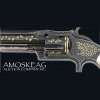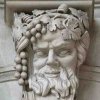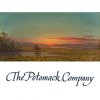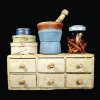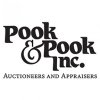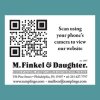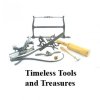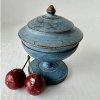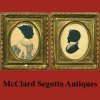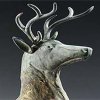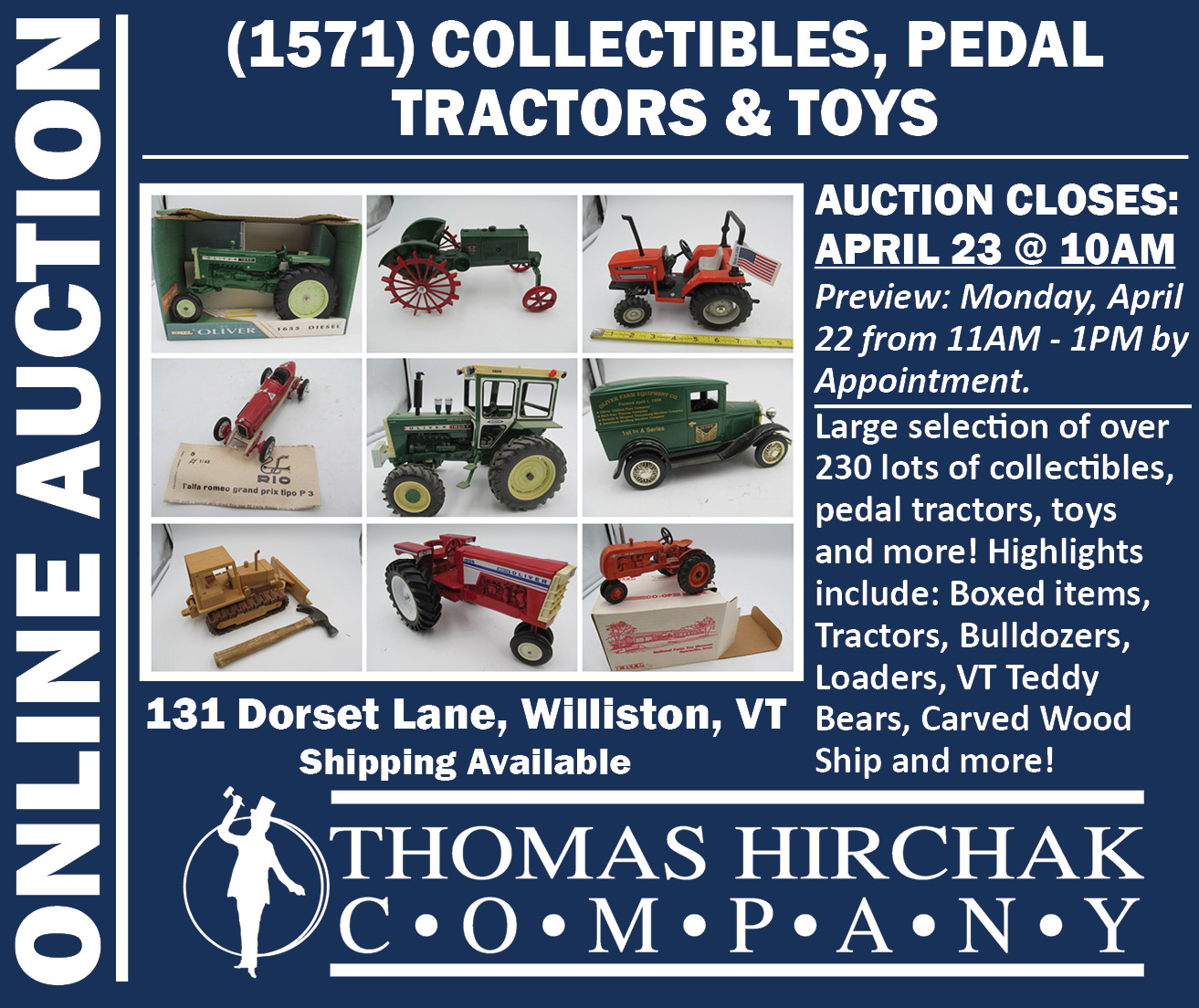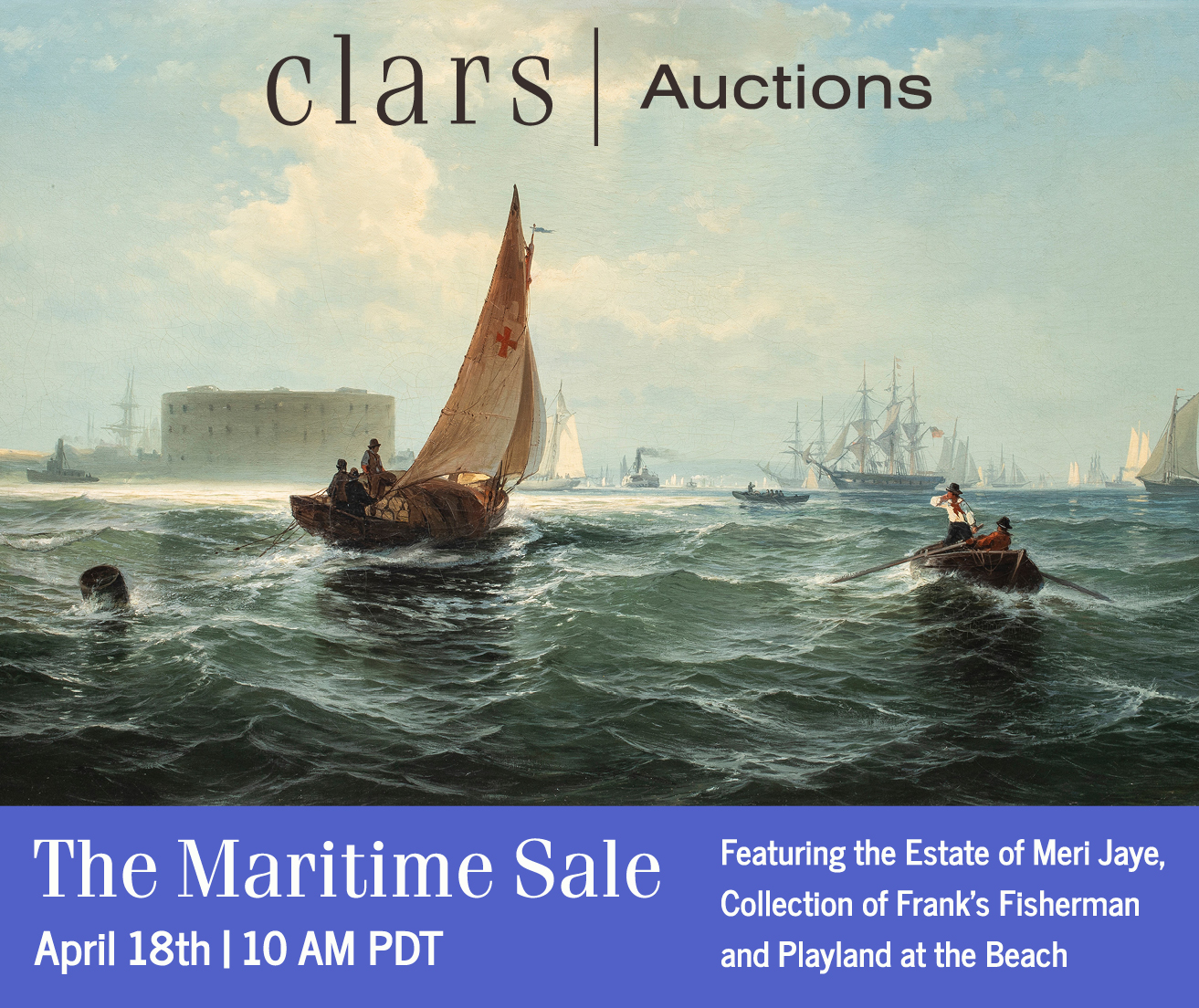Rare Books in the Big Apple
April 11th, 2013
|
Jeremy Markowitz (left) and Tom McLaughlin of Donald A. Heald Rare Books, New York City. Their natural history offerings included a first elephant folio of The Viviparous Quadrupeds of North America by John James Audubon and Rev. John Bachman, price on request.
The first book illustrated by Rockwell Kent (1882-1971) was Architectonics: The Tales of Tom Thumbtack Architect by Frederick Squires. Published in 1914, this copy was $750 from Tamerlane Books, Havertown, Pennsylvania.
Kurt Vonnegut often signed books with a self-caricature like this one found in a first edition first printing of his 1969 novel Slaughterhouse-Five: or The Children’s Crusade: A Duty-Dance with Death. The book was offered at $6500 by B & B Rare Books, New York City.
Charles Agvent of Mertztown, Pennsylvania, asked $4500 for a handmade sign advertising Charles Bukowski’s first known poetry reading, at the Bridge, a bookstore in Los Angeles, December 19 and 20, 1969. It came with a 1994 letter from Bukowski’s bibliographer, Sanford Durbin, documenting its authenticity and telling a great story about how the sign was acquired.
Seth Kaller holds a copy of Thomas Paine’s Common Sense. Initially, Kaller explained, Robert Bell of Philadelphia published the pamphlet in January 1776, and it sold out quickly. Paine asked Bell to hold off on a second issue to allow time for supplementary work. Bell, seeking to avoid paying royalties, instead advertised an unauthorized “new edition,” reprinting the original. Furious, Paine went to William and Thomas Bradford to republish his original text along with additional material, including Paine’s first use of the phrase “the Free and Independent States of America.” This is the most complete of the first editions, said Kaller, whose price for his Bradford-published volume was $68,000.
Charles Agvent holds an autograph letter signed by Woody Guthrie discussing the folk music scene of his day and championing Pete Seeger. Written in several colors of ink while Guthrie was at the Brooklyn State Hospital, where he spent several years, the three pages were sent to the magazine Sing Out! in 1955. Agvent priced it at $15,000.
One specialty of Raptis Rare Books, Brattleboro, Vermont, is finance and economics. Titles of signed first editions in the vitrine included Value and Capital by J.R. Hicks, published in London in 1939, priced at $9500; John Kenneth Galbraith’s The Great Crash of 1929, Boston, 1955, $4500; and Paul Samuelson’s Foundations of Economic Analysis, Cambridge, 1947, $12,500. “The conventional view serves to protect us from the painful job of thinking,” Samuelson wrote.
Just before posing, Lorne Bair (right) of Winchester, Virginia, sold a Soviet propaganda poster. A specialist in 20th-century social movements, Bair filled the vitrine behind him with titles such as Josephine Herbst’s Nothing is Sacred (1928), $950; Mary Harris Jones’s The Autobiography of Mother Jones (1925), $500; John Steinbeck’s Of Mice & Men (1937), $1250; John Dos Passos’s One Man’s Initiation (1917 and 1920), $1200; and Eldridge Cleaver’s Soul on Ice (1968), $250. The dealer’s location isn’t known for radicalism, but Bair said, “I haven’t had a brick through a window yet.”
Anne C. Bromer of Bromer Booksellers, Boston, is pictured with Miniature Books: 4,000 Years of Tiny Treasures (2007), which she cowrote with collector Julian I. Edison in conjunction with a 2007 exhibition at the Grolier Club in New York City. The book is considered to be the first lavishly illustrated and authoritative book on the subject of books no taller than three inches. Edison, who lives in St. Louis, was at the fair looking for more miniature books, said Bromer. He has been editor of Miniature Book News for more than 40 years.
A first edition, first printing, of Richard Henry Dana Jr.’s Two Years Before the Mast (1840) was $10,000 from Peter L. Stern & Co., Boston. In entirely original condition, with its original tan muslin cloth covers and without repair or restoration, it is indeed a rare book. |
New York Antiquarian Book Fair, New York City
I’d been told by rare book dealers I knew from the Boston International Antiquarian Book Fair that I needed to go to that show’s New York counterpart to experience the real thing. Both are sponsored by the Antiquarian Booksellers’ Association of America (ABAA) and attract a roster of dealers from around the nation and beyond. But the New York version is bigger, better, more international, and more likely to be attended by the best collectors in the world, the dealers said.
Those who voiced these sentiments weren’t necessarily from New York. What they said had nothing to do with the celebrated Boston-New York rivalry. Even dealers from Boston urged me to take a bite of rare books in the Big Apple. So I went to the Park Avenue Armory for the 53rd annual New York Antiquarian Book Fair, where some 212 firms were exhibiting from April 11 to 14. What I found can be summarized in a phrase: It’s the same but different, and vive la différence. There’s no place like New York City.
Even just waiting in line to get into the preview, I spied many notables. They included Eric C. Caren of Lincolndale, New York, proprietor of The Archive, who introduced me to someone he characterized as the country’s preeminent collector of Mormon material. Wyatt Houston Day, founder of Swann’s African-Americana department, made his way past us as we chatted. So did Bruce E. McKinney of San Francisco, whose Web site, The Americana Exchange (www.americanaexchange.com), publishes an enormous statistical index of pricing history for books, manuscripts, and ephemera. Behind me was a man who publishes translations of technical books produced by a multilingual team of translators. Ahead, I recognized the white-bearded underbidding agent who tried to buy (up to $2.6 million) the record-breaking Francis Crick letter that sold at Christie’s for $6.05 million on April 10. (See the story about the letter on p. 14-C.)
It was an interesting gathering, and it would be an interesting night. In the first five minutes, I saw Lewis Carroll’s own annotated copy of Eight or Nine Wise Words about Letter Writing, priced at $25,000 from Benjamin Spademan Fine & Rare Books, London. I also saw a pair of size 34 monogrammed boxer shorts that had belonged to Eugene O’Neill. “One of only two pairs known,” said Dan Dwyer of Johnnycake Books, Salisbury, Connecticut, who was offering the blue-and-white pinstriped underwear for $1750. Moving on to the sublime, I saw F. Scott Fitzgerald’s walking cane given him by Max Perkins. Maker unknown, the circa 1927 cane was banded with a simple gold plaque inscribed by the editor to his author. It was priced at $75,000 by Ursus Rare Book, New York City.
Nicholas T. Cooke of Black Swan Books, based in Richmond, Virginia, had a Washington College report card, signed in 1866 by its then new president, Robert E. Lee. Six months after surrender, the Confederate army general headed the college, later renamed Washington and Lee University. The card bears no recipient’s name, but it was likely Lewin W. Barringer’s, said Cooke, who told me that diplomas signed by Lee are “floating around, but not many report cards, and few as dismal as this one.” Its price was $5000.
William Reese Company, New Haven, Connecticut, featured an Abraham Lincoln manuscript in the presidential hand that relates to Reconstruction and is therefore extremely rare. Undated but “almost certainly” drafted in the midst of the war, it discusses the president’s right to grant amnesty to Confederate prisoners, among other issues that demonstrate Lincoln’s farsightedness in shaping the future reunification of the United States, said the company’s fair catalog. The manuscript’s price was $475,000.
Seth Kaller of White Plains, New York, brought the “Lincoln Nomination Chair.” Made of bentwood hickory and painted black, it is the chair in which Lincoln was sitting when he learned he had received the Republican nomination for president in 1860. Kaller bought it at the James S. Copley Library sales at Sotheby’s on May 20, 2011. At the time, there was no convincing documentation that it truly was Lincoln’s, with Sotheby’s noting only that “Lincoln purportedly settled into this chair during his frequent visits to the office of Simeon Francis, editor of the Sangamon Journal in Springfield, Illinois.”
Kaller himself was skeptical about the chances that the proof could be found. “I bid because I enjoyed looking at it, and the downside was limited with an extremely low estimate.” After buying it, he told his staff not to bother researching it. “I said, ‘What are we going to do? Find a contemporary newspaper article talking about Lincoln sitting in it?’” But he was swayed to let them try, and after more than 100 hours of research, they found such an article printed while Lincoln was still alive. They also found documentation that Lincoln had been sitting in this chair when he received word that he had been nominated for the presidency.
“We were able to document an amazing chain of ownership,” Kaller said. “When an item captures my interest, we can take a chance, and once in a while it pays off.” Their research is now on his Web site (www.sethkaller.com), and the chair was priced at $150,000.
One thing about my New York experience was very much like the Boston experiences I’ve had. Only about half the items I ogled at this fair were books. Many of the rest, like the shorts, cane, and chair, weren’t even paper. I wondered if it was a failing in me to be attracted to non-reading matter, but one dealer was reassuring. “Everybody does it,” he said. “Visual objects are easier to grasp.” That’s also why antique maps have lately been doing well, that same dealer ventured.
Its visual impact was only one of the reasons Paul Cohen and Henry Taliaferro of Cohen & Taliaferro in New York City quickly sold their special copy of Joshua Fry and Peter Jefferson’s “A Map of the most Inhabited part of Virginia containing the whole Province of Maryland,” published in 1775. As the dealers told me, this is “the most historically important and beautifully colored example” of this edition.
The map once belonged to Michel Capitaine du Chesnoy, the Marquis de Lafayette’s personal mapmaker, and he used it as the pattern for one of the most important maps of the American Revolution, Lafayette’s large manuscript of his campaigns in Virginia. Copies of that are at Yale University, the Library of Congress, and Colonial Williamsburg, and each has a pencil-lined grid of Virginia east of the Blue Ridge Mountains. The grid was employed as the guide for transposing Fry and Jefferson’s geography onto the larger manuscripts. Capitaine du Chesnoy’s copy of the printed map has the same penciled grid extending to the Blue Ridge Mountains, but it was executed on a smaller scale, so that troop movements could be clearly delineated. It also could be folded down to a compact size that would have been easy to transport to a battlefield.
The shift from books to non-book items at the fair has been gradual but unstoppable, said Gregory Gibson of Ten Pound Island Book Company, Gloucester, Massachusetts, who specializes in marine and nautical history, voyaging, whaling, yachting, and other watery themes. “It’s not about books anymore,” he told me hyperbolically, citing the Internet as the biggest agent of change. “The fair is immeasurably different from what it was. What can we do about it? We just try to adapt. We can’t stop it. We just have to learn to figure it out.” For his part, Gibson said, ten years ago, he would have brought 170 books, but this year he brought exactly 17.
I like to think that the way book fairs have expanded their reach into other collecting areas demonstrates how great ideas take many forms. What we all have to do is what we’ve always done: recognize and champion the great ones.
Not all great ideas are as august as the Lincoln draft noted above. Sometimes they simply bring pleasure. Those who enjoy detective stories should give thanks to John B. Williams’s great idea. He wrote Leaves from the Note Book of a New York Detective: The Private Record of J.B., published in New York in 1865. The book, allegedly the casebook of New York consulting detective James Brampton, is considered to be perhaps the first depiction of an American urban detective hero. Cliff Graubert of the Old New York Bookshop, based in Atlanta, Georgia, had a first edition for sale in a custom slipcase at $8000.
Whether dealers asked higher prices at the New York show than they do elsewhere, I couldn’t say. I do know that the rare book arena of collecting is a comparatively inexpensive one to enter. I saw many items for under $1000 and noted only one item over $1 million at the fair. It was a copy of the so-called “Columbus Letter,” offered at $1.3 million by Jonathan A. Hill of New York City. Published in Basel in 1494, it is Columbus’s account of his successful voyage of discovery, illustrated with six woodcuts. Many editions were published of this bestseller of its day. All are extremely rare. There is no known manuscript version of the letter, which is addressed to the Spanish sponsors of his voyage, King Ferdinand and Queen Isabella.
Given all that, the price seemed fair to me, but others would probably disagree. “I don’t ‘get’ paper,” a clock collector said when I told him where I was going for the weekend. I thought of his comment when Lisa Holley, wife of dealer James Arsenault of Arrowsic, Maine, said to me early on the second day of this show: “In the big sea of people who don’t get it, it’s nice to be in a place where people do.”
The Arsenault booth had a good opening, Holley said that day. When we caught up with Arsenault via e-mail afterward, he told me: “We had a solid show with a nice mixture of retail and dealer trade. Opening night was stronger than usual. The scene in our booth became quite lively as soon as the doors opened, in part a consequence of being at the front.” Booths are assigned at ABAA shows through a lottery system. He added: “There were quiet stretches on Friday and the weekend, as is typically the case at this fair, but all in all it was quite satisfying. We met several new customers and expect good long-term results. New York is always worthwhile for us, and this year was no exception.”
Ian Brabner of Wilmington, Delaware, said: “This is the best antiquarian book fair in North America, so if it’s going to be a buying crowd, New York is the place where they’ll go. It’s a great show with a lot of energy, and a lot of interesting people come walking through, and they represent all kinds of collecting interests.”
Brabner called the crowd more “robust” this year than in recent years and partly attributed it to attention given to the fair by media. “There was more than I’ve seen in the past,” he said. “It’s hard to get traditional news outlets interested in these kinds of events,” he added, “unless there’s a celebrity sighting, and there are those at this fair.” He named, for example, Yoko Ono, who usually attends. He didn’t see her this time, but did see Ricky Jay, a celebrity as much for being a collector as for being a magician, actor, and writer. “That ended up being a story,” Brabner said.
What made me happiest, though, were news stories I saw that focused on “celebrities” such as William Henry Harrison, Albert Einstein, and Jonathan Swift, each of whom was represented in materials in dealers’ booths at the fair.
John C. Thomson of Bartleby’s Books, Washington, D.C., is the ABAA’s president. “I thought the energy at the fair was higher than it has been since the recession and felt an activity level there that seems to indicate that the market is rebounding,” he said. “My own fair was good. It wasn’t like the go-go years, and I didn’t hear people talking about having had their best fair ever. My sense was that most people talked about having a good fair.” These days, “good” is great to hear.
I have mentioned only a minimal number of international dealers because I chose to concentrate mostly on American items in the booths of American dealers for the readers of M.A.D. Sadly, that left about 80 booths unexplored—e.g., Abeceda Antiquariat, Munich, whose specialties include design, illustrated books, and photography; Librarie Bardon, Madrid, whose areas of concentration are exploration and Hispanica; Bibliopathos, Verona, whose concentrations are incunabula, law, and the Renaissance; and Librarie Alain Brieux, Paris, with offerings of books on medicine and science.
If you do go to this fair, even if you are a focused collector, reserve time simply to browse and possibly awaken new collecting interests. You’ll also want to visit the “shadow show,” the Manhattan Vintage Book & Ephemera Fair, managed by Flamingo Eventz. (See story on p. 29-B.) Make time for the auctions and auction previews, too. We went not only to Christie’s but to a sale at Heritage Auctions, a preview at Swann Galleries, and a display of highlights from a sale at Profiles in History in Calabas, California, scheduled for May 30. (On our “downtime,” we went to the Metropolitan Museum of Art to see the deeply moving exhibit Photography and the American Civil War. A review is in the works.)
Some people complained that it was too much book culture to absorb. Maybe so, but we added to the full immersion experience by staying at the Library Hotel (www.libraryhotel.com) at Madison Avenue and 41st Street, where each of the hotel’s 60 rooms is stocked with used books from a certain section of the Dewey Decimal System. Our room was 400.005, i.e., Middle Eastern language. On a previous stay, we got 1100.002, i.e., ethics, where I picked up a book I wouldn’t normally choose: A Guide to the Good Life: The Ancient Art of Stoic Joy by William B. Irvine. I highly recommend it.
The entrance to the circa 1912 hotel is on 41st Street, on a block that’s part of what’s called Library Way. From the second-floor breakfast room, one can see the New York Public Library at 5th Avenue and 42nd Street in the distance. Embedded in the sidewalk leading up to the library are 100 bronze sidewalk plaques featuring quotes about books and reading from literature. One says: “Where the press is free, and every man able to read, all is safe.” It’s from Thomas Jefferson’s “Letter to Colonel Charles Yancey.”
For more information, contact the ABAA through its Web site (www.abaa.org) or see the show Web site (www.nyantiquarianbookfair.com).
Originally published in the July 2013 issue of Maine Antique Digest. © 2013 Maine Antique Digest

